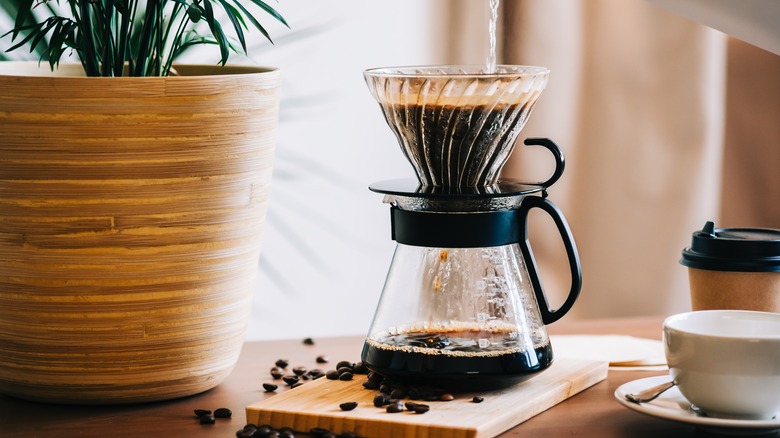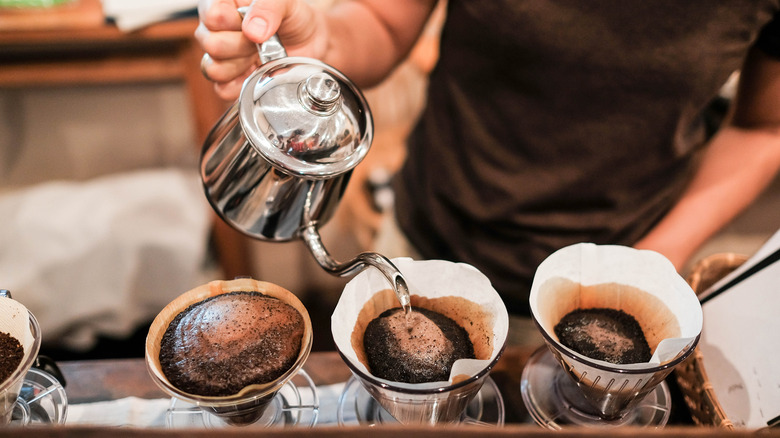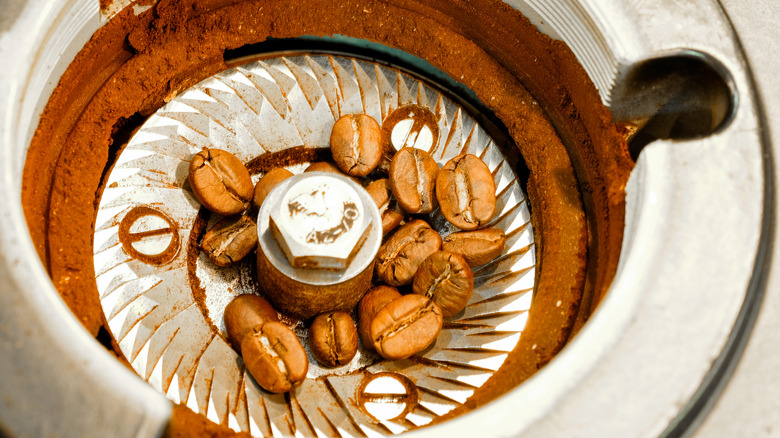The Best Type Of Grinder To Use For Pour Over Coffee
Pour over coffee was around for more than a hundred years before it became a coffee-shop trend. The pour over method emerged from some humble experimentation by a German woman named Amalie Auguste Melitta Benz, who changed her daily coffee brewing ritual with a homemade contraption one day in 1908. Using household items, including blotting paper from her child's schoolbook, a brass pot, and a nail, her makeshift invention not only makes her the mother of coffee filters and gravity-fed drip coffee, but her method vastly improved the flavor and consistency of a basic cup of joe, notes Melitta.
You may recognize Melitta pour over coffee makers based on the original and later cone-shaped designs, which work on similar principles to today's conical V60 and Chemex drippers, as explained by Perfect Grind Daily. Though multiple versions exist now, one thing remains constant in the opinion of java expert: the bean grind is what most dictates a successful cup of pour over. Fortunately, it's as simple as choosing the right type of grinder.
The daily grind matters
When it comes to pour over coffee preparation, the beans are ground zero. Obviously, you'll want freshly roasted whole coffee beans in your preferred flavor, but once you have this, it's what you do with those beans that really matters. Basically, all coffee experts say you'll get the best flavor by grinding them in your own home machine. Coffee grinders come in electric or manual versions, so if you're off-grid or just a low-tech purist, a manual grinder is probably your style. Besides the question of power, there's whether you choose a burr or blade grinder.
This one we'll settle for you now — don't even think about using a blade grinder for pour over coffee. Blue Bottle Coffee explains that burr-style grinders are the only ones that provide a uniform coffee grind, which is essential for extracting the essence of the beans. Further, you want a burr grinder that lets you adjust the size of the grinds, which also rules out many models on the market.
In the world of coffee, the finest ground pieces are known as "fines," and the larger bits are appropriately called "boulders." But a high-quality burr machine does a better job producing a smooth, consistent result. An uneven grind can lead to an under- or over-extraction, which will put a bitter brew in your cup.
Why not a blade grinder?
In contrast to a burr coffee grinder, a blade grinder doesn't actually grind your coffee beans, but chops them up into smaller pieces, notes Coffee Confidential. Also known as whirly or propellor grinders, they slice, dice, and shave the beans with blades that rotate 20,000 to 30,000 times per minute and can generate heat that can actually burn the coffee beans. If you really must use a blade grinder, occasionally pause it during the process to let the blades cool down.
As mentioned, blade grinding produces an inconsistent result of small and large bits of coffee beans, leaving you with something that will produce a precarious potion rather than a carefully crafted cup of java flavor, according to Coffee Hit. The lack of uniformity creates a smaller surface area for the hot water to interact with, robbing you of that extra coffee flavor and depth you deserve.


